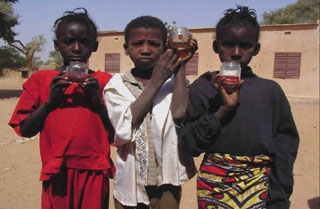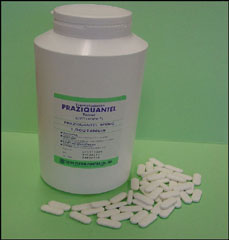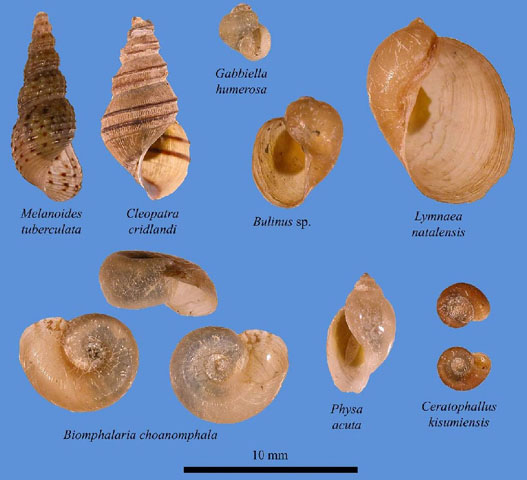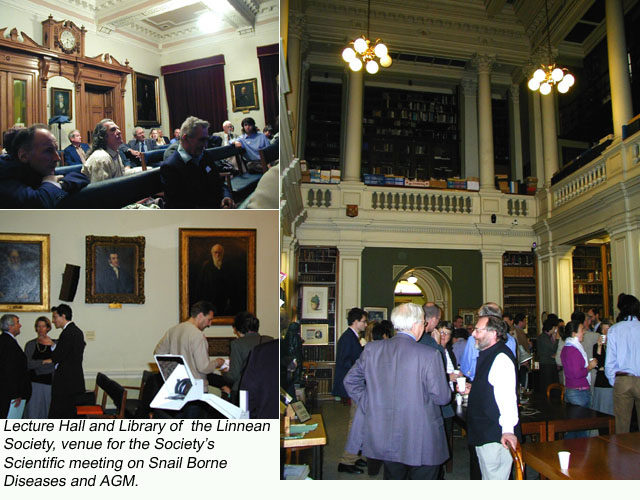

Scientific meeting of The Malacological Society of London, held on Thursday 28th April 2005

Children holding red urine samples, a visual sign indicative of S. haematobium infection. (Courtesy of SCI)
Dr Russell Stothard
(r.st...@nhm.ac.uk) warmly welcomed everyone to Burlington House
for this afternoon scientific meeting held jointly with The Royal
Society of Tropical Medicine and Hygiene and The Linnean Society
of London to learn more about snail-borne diseases. By uniting aspects
of their epidemiology and natural history, the meeting hoped to
draw together common themes of these fascinating, yet devastating
diseases. With a total of eight invited speakers, before tea and
viewing posters, the first session, was devoted to clinical and
parasitological aspects while more snail-related aspects were aired
during the second session. Providing a suitable platform for discussion
and debate, the meeting aimed to attract further focus upon medical
malacology and an opportunity to acknowledge the significant contributions
to this field by the late Drs David Brown, NHM and Georg Mandahl-Barth,
DBL.
The first of the afternoon talks took a clinical tour through the
commoner snail-borne diseases seen at The Hospital for Tropical
Diseases (HTD), London. Prof. Peter
Chiodini (pete...@uclh.org) showed that each
year typically 500 in-patients, with a further 6, 500 out-patients,
were seen and screened for parasitic and infectious diseases at
HTD. Infections could have been contracted in any part of the globe
and as a full and detailed diagnostic service is available at HTD,
this patient database often provides an important window into many
diseases throughout the world. Infections with the trematode worms
Clonorchis (intestinal fluke), Fasciola (liver fluke) and
Paragonimus (lung fluke) can be often seen in refugees,
immigrants and tourists requiring medical attention within the UK
but the majority of snail-borne infections are, however, attributable
to Schistosoma (blood fluke) with 200 cases per annum of
either urinary or intestinal schistosomiasis.
The infection processes of these snail-borne trematodes can be broadly
divided into oral and(or) trans-dermal routes of the worms’
larval stages which have been previously released from infected
(semi)aquatic snails. During development within the human body,
clinical symptoms include urticaria and fevers. After maturation
and, depending upon the species of infection, the resultant adult
worms reside within the blood vasculature system or internal body
cavities of the human host but unlike other parasitic infections,
the worms do not directly replicate inside the body but rather produce
copious amounts of eggs. It is these eggs which, depending upon
the species concerned, may be voided to the environment via sputum,
urine or faeces, facilitating the lifecycles of the parasites. Those
eggs that fail to exit the body, often become trapped in host tissues
and organs, and ultimately trigger the immuno-pathology associated
with disease. For example, liver and(or) spleen enlargement can
be often seen with Schistosoma mansoni infections while lesions
within the uro-genital system are typical of S. haematobium infections.
Typically sputum, urine and faecal samples are inspected for parasitological
diagnosis using microscopy. However, making a clear and firm diagnosis
can sometimes be difficult if eggs are not apparent in the specimen.
In such instances a combination of clinical acumen, serology and
antigen detection methods may be required although treatment of
infections are relatively straightforward. In the vast majority
of cases, oral treatment with anthelmintics such as praziquantel
(PZQ) is administered on an out-patient basis unless, however, central
nervous system complications are known where co-administration of
corticosteroids may be necessary under hospital supervision. While
PZQ is cheap and effective, Prof. Chiodini expressed his concerns
that as no other anthelmintic drugs alternatives were presently
available, should drug resistance ever occur, this could dramatically
change future patient prognosis which is presently very good.

Oral praziquantel, a cheap effective treatment for schistomiasis (courtesy of SCI)
In stark contrast to the very good clinical prognosis of schistosome-infected cases in the UK, in regions of the world where schistosomiasis is endemic and access to PZQ is severely limited e.g. sub-Saharan Africa, patient prognosis is very poor. Some 200 million people are presently infected with schistosomes and the global disease burden attributable to schistosomiasis, especially within school age children is alarming. Prof. Alan Fenwick (a.fe...@imperial.ac.uk) clearly drew attention to recently revised estimates of the mortality associated with urinary and intestinal schistosomiasis of 150K and 130K per annum respectively. In fact for an infected child in Africa the picture is particularly bleak as the disease is known to play a significant role in enhancing the vicious circle of poverty by maintaining malnutrition & anemia, growth retardation, cognitive impairment and increased susceptibility to other infections. To break out of this vicious circle it is necessary to provide regular anthelmintic treatment and today, with the recent dramatic decline in the price of PZQ, the cost of drug needed for treatment of each child can be as little as US$ 0.07. Indeed the World Health Assembly and Global Millenium Development Goals have very strongly advocated mass use of PZQ in all countries of the world where schistosomiasis is endemic.
Cheap drugs alone are not sufficient to get national de-worming
treatment campaigns moving and Prof. Fenwick highlighted the recent
exciting progress of the Schistosomiasis Control
Initiative (SCI) within Africa (see www.schisto.org). The
SCI was initially funded with a start-up grant of US$ 30 million
from the Bill & Melinda Gates Foundation to encourage several
sub-Saharan countries to implement their nationwide de-worming programmes
by providing both financial and technical assistance. This has directly
resulted in over 3 million children in Niger, Burkina Faso, Mali,
Uganda, Tanzania and Zambia having had a least one round of annual
de-worming treatment. As the control programmes expand and annual
retreatments are given out, the total number of children benefiting
from continuing access to the drug will continue to increase. To
better plan for sustainability, thinking beyond de-worming is necessary
for improving the health of the world’s poorest people. To
streamline the costs of PZQ delivery, attempts are being made to
provide an essential package of drugs for control of trachoma, lymphatic
filariasis, and intestinal worms and for the extended programme
of vaccinations (measles and polio) as well as increased use of
nutritional supplements such as vitamin A.
Still with increasing drug usage and higher treatment coverage,
the potential threat of evolution of drug resistance to schistosomiasis
remains. Drs Juerg Utzinger &
Jennifer Keiser discussed the search for novel treatment
options for schistosomiasis as well as for other trematode infections,
the drug of first choice for the latter being triclabendazole. Both
schistosomiasis and food borne trematodiasis will become ever increasingly
important in Asia, in particular China, as the future expansion
of irrigated areas continues and as the increase in aquaculture
creates further conditions favourable for disease transmission.
It is expected that some several tens of millions of people will
become infected over the next decade. With this in mind there is
a very clear remit for drug research, planning for these future
needs. One way forward is in the use of existing plant Artemethers
and chemical synthetics, which are very active anti-malarial compounds,
in the newer context of anthelmintics. Should PZQ ever become ineffective,
research has shown that Artemether holds much promise as a future
alternative treatment for trematodiasis.
After breaking for tea and viewings selection of posters, Dr
David Rollinson (d.ro...@nhm.ac.uk) showed the
multi-disciplinary nature of contemporary medical malacology research
and how molecular DNA methods have been providing new insight into
old problems. For example, development of a precise taxonomy of
Bulinus and Biomphalaria has been previously problematic
as there are very few amenable anatomical characters for inspection
and shell morphology is notoriously misleading. As a consequence
the understanding of the phylogeny and evolution of these species
has been limited, although demonstrating the roles of such nominal
species in the transmission of Schistosoma spp. Detailed
molecular investigation in Zanzibar and Senegal have revealed the
importance of the snail in determining the epidemiology of the disease.
On Zanzibar, the geographic distribution of urinary schistosomiasis
in man is highly correlated with the distribution of populations
of Bulinus globosus, and Bulinus nasutus
is refractory to infection. This latter finding could find important
application in biological control of schistosome infections in the
environment through manipulation and displacement of B.globosus/nasutus
populations. Similarly the low genetic diversity and high compatibility
of Biomphalaria pfeifferi in Senegal has no doubt
assisted in the local epidemic of schistosomiasis around Richard
Toll.
Genomic-wide approaches using DNA chip (microarrays) methodologies
are starting to grapple with the molecular determinants of snail-schistosome
compatability by looking at the expression of genes within the snail
following penetration of miracidia. Using selected breeding lines
of Biomphalaria glabrata that are resistant or
susceptible to infection, several novel genetic determinants have
been isolated following their up- or down-regulation expression
patterns. Dr Rollinson drew attention to a possible drawback, however,
that with many of these novel genetic targets, the molecular functioning
remains difficult to identify precisely using GenBank sequence homology
searching. In contrast, to molecular research on insect vectors
of disease, where for example there are many mosquito DNA accessions,
molluscan data is presently under represented and there is room
for improvement. Similarly, integration of laboratory and field
studies is required to understand the interactions between snail
and parasite populations and it is necessary to use this knowledge
to bolster interventions based upon chemotherapy as well as to explore
novel methods for improving schistosomiasis control in the environment.
Past experiences have shown that populations of intermediate snail
hosts have often proven rather difficult to control. As snails have
successfully colonised many areas of Africa and have evolved to
meet the needs of these rather ephemeral habitats where population
crash and boom is the norm, actions by man are often circumvented.
Dr Bertrand Sellin
(Bert...@wanadoo.fr) showed that their general adaptability
and high reproductive rates have allowed Bulinus and Biomphalaria
to endure within many varied environments as well as withstand chemical
methods of snail control with aquatic molluscicides. Despite these
frustrations field studies of molluscs remain an essential part
of a multidisciplinary approach to control and to better understand
the complex epidemiology of these diseases. Detailed documentation
of the snail population dynamics provides important information
for optimal timing of chemotherapy as well as better guiding water
resource development and management. For example, such results can
help to motivate local communities in showing the success of their
attempts to clean canals, keeping snail populations at bay, and
therefore minimising the opportunity for schistosome transmission.
By reducing the opportunity and rate of reinfections, such actions
help to build towards more sustainable control by maximising the
benefit of chemotherapy.
Molecular approaches have also shed light on the epidemiology of
Asian schistosomiasis, in particular Schistosoma japonicum
in China and the Philippines. In contrast to African schistosomes,
this asian schistosome utilizes the amphibious snail Oncomelania
hupensis (within which molecular DNA work has revealed
possible cryptic species) and uses a broader definitive host range
of cattles, rodents, pigs and dogs as well as man. Dr
Joanne Webster (Joan...@imperial.ac.uk) reviewed
the progress made using microsatellite DNA markers to better describe
the distribution of schistosome communities within both molluscan
and mammalian hosts. Using PCR approaches it is possible to inspect
variation of schistosome larval stages and better monitor any genetic
heterogeneity. Genetic variation is apparent and as a direct consequence,
it appears that the same strains of S. japonicum co-circulate within
humans and cattle but remain separate to those within domestic animals,
yet all schistosomes use the same species of snail. This raises
interesting spatial evolutionary questions regarding potential for
co-evolution and determinant of the temporal patterns of infection
within the snail.

Shells typical of the snail species found in Lake Victoria (coutesy of Prof. Thomas Kristensen)
The importance of general levels of aquatic snail biodiversity was highlighted by Dr Thomas Kristensen (tkkr...@dblnet.dk). For example owing to their complex lifecycles, the geographic distribution of several snail borne diseases is mainly constrained by the presence of particular species of freshwater gastropod within which infections can successfully develop. Schistosomiasis is perhaps the best known, and in examples taken from Tanzania, Zimbabwe, Ghana and Uganda clear patterns between snails and schistosome can be seen. As often only a single snail species acts as a local intermediate host, it is important to identify snail populations precisely, differentiating between species that are intermediate host species and those that are not. On the other hand the parasite is often less discerning and may penetrate non-host snails and in so doing die. Indeed the presence and diversity of non-host snail species can curtail parasite transmission by blocking the development of larval stages of the parasite. At the same time changes in the environment associated with man’s activities can greatly influence the diversity and density of freshwater gastropods which may favour disease transmission. Indeed such changes have been seen after creation of water impoundment schemes (e.g. Ghana and Egypt) or as consequences of human pollution and over-fishing (e.g. Malawi and Kenya). The changes may manifest themselves rapidly with outbreaks of snail-borne diseases over a short time scale or can be more gradual and subtle where in the patterns of the parasitic faunae alter for example where S. haematobium is replaced by S. mansoni or vice versa.
After giving thanks to the speakers and to The Linnean Society for
generously providing the hosting venue, Dr Russell Stothard invited
Dr Vaughan Southgate
(vrs...@nhm.ac.uk) to review the afternoon’s findings and guide
an open questioning session from the floor. Great progress and in-roads
have been made into combating morbidity control of snail-borne diseases
with PZQ. Such treatment campaigns are having tangible impacts upon
improving the health of children in the developing world, especially
where previous health services have failed to provide access to
anthelmintics. On the other hand, growing concerns are now being
raised, and faced, when issues of the longer-term sustainability
of chemotherapy-based programmes are discussed.
Piggy-backing de-worming drugs with other common tropical disease
medicines to form an essential drug package is certainly the way
forward. As with any drug, however, control focused upon one drug
alone will eventually have a finite period of efficacy as the potential
threat of evolution of drug resistance is realised. In fact, drug
resistance is being taken very seriously and a concerted action
group exists to monitor the tolerance and susceptibility of schistosomes
to praziquantel. So far there is no clear evidence to suggest any
erosion of drug efficacy but clearly this situation needs to be
continuously monitored. There are strong ethical arguments too for
maintaining drug delivery even if PZQ resistance was detected. For
example, while the drug still exhibits some benefit in terms of
reduction of suffering then why should such medicines be restricted
in their use within the poorest communities who live in the greatest
need of treatment? As with any other ‘vector-borne’
disease, snail-borne diseases are no exception; medical malacology
is an essential component within disease surveillance. Are snail-borne
diseases still a threat to global health? Simply put, as there are
still hundred of millions of peoples on the globe living in impoverished
conditions of poor sanitation and water-hygiene and in close proximity
to susceptible snails, the future burden of snail-borne disease
will still be devastating.
Acknowledgements
The meeting greatly benefited from the kind hospitality of staff
of the Linnean Society in particular Mr Adrian Thomas. Financial
support from the SCI, Imperial College was gratefully received to
meet the travel costs of Drs Utzinger and Keiser.
Dr. J. Russell Stothard
Wolfson Wellcome Biomedical Laboratories
Biomedical Parasitology, Department of Zoology
Natural History Museum, London SW7 5BD
e-mail: r.st...@nhm.ac.uk
